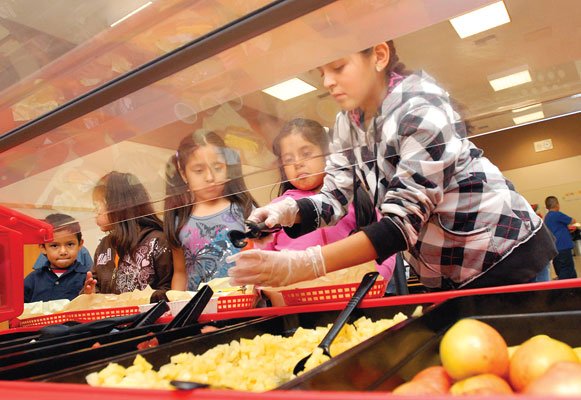Nearly half of Gilroy’s public school students receive free or
reduced-priced lunches as part of a program that’s largely based on
the honor system.
Nearly half of Gilroy’s public school students receive free or reduced-priced lunches as part of a program that’s largely based on the honor system. Furthermore, enrollment in the program is linked to federal funding in such a way that the more students that receive discounted lunches, the better the district looks academically and does financially.
Every day, the National School Lunch Program serves more than 30.5 million children across the country. In the Gilroy Unified School District, with about 10,900 students, 4,681 children receive free lunch and 582 receive lunch at a reduced rate of 40 cents per meal, according to Deputy Superintendent of Business Services Enrique Palacios. The remainder of students pay $2 for their lunch.
Children from families with incomes at or below 130 percent of the poverty level are eligible for free meals. For example, children from a family of four with an annual household income of $28,665 or less receive free lunch. Children from families with incomes between 130 and 185 percent of the poverty level – or between $28,665 and $40,793 annually for a family of four – are eligible for 40-cent meals. Subsidizing free and reduced lunches for Gilroy students costs the federal government $2.26 million annually, based on Dispatch calculations.
Yet, the application process is largely based on honesty, district staff said. The one-page application, printed in English and Spanish, requires families to provide the names of all household members, gross monthly earnings, address and phone. Although a designated space exists for an applicant’s Social Security number, providing one is not mandatory and applicants can simply write “none” if they don’t have one, according to the form. Pay stubs, tax returns and other forms verifying income are not required.
Each year, the district polices the system by auditing a random sample of about 5 percent of the applications and requesting additional documentation, Palacios said. It was unclear how many of these audited applications prove fraudulent.
“There is no abuse of the system,” he said. However, he acknowledged that “no government program is 100 percent foolproof.”
According to the application, the “deliberate misrepresentation of the information may subject (applicants) to prosecution under applicable State and Federal laws.”
Though Eliot Elementary School Principal James Dent said he had “no idea what the rate of dishonesty” was at his school, “it’s better that kids are being fed than not.”
Eliot – a school where four in five children received free or reduced lunch in the 2007-08 school year, the most recent year for which the district had data available on its Web site – serves the highest percentage of poor students in the district. Dent estimated that this year, about 95 percent of students receive free or reduced lunch, up significantly from 2007. Given the economy and the background of his students, he said the high rate of students enrolled in the program does not surprise him.
“Most of our parents are not even high school graduates,” he said. “Even if parents are taking advantage of the system, I would lean toward taking care of the kids first. A hungry kid is not going to learn.”
The district’s money is better spent on teaching students than policing the system, Dent said.
“If you have a healthy lunch, you get to concentrate more because it’s hard to figure out an answer when your stomach hurts,” student Kim Paredes, 8, said between bites of French fries and fish sticks and sips of chocolate milk.
The district is reimbursed $2.70 from the federal government for every free meal and $2.30 for every reduced-priced meal. Additionally, the district receives 27 cents for every paid meal, Palacios said. Between federal subsidies, a small state subsidy and cash sales, the district’s approximately $3.5 million food service budget is “self-sustaining” and does not require general fund money.
The number of low-income district students – defined by those who receive free or reduced lunch – helps determine the amount of federal funding it receives. Eliot receives as much as $120,000 in Title I federal funding for schools with high numbers of poor children, Dent said.
In addition, when the state releases a school’s standardized test results, the school’s results are generally compared to similar schools, so having a high population of students that receive free or reduced lunches means a school will be compared to a less competitive group.
Trustee Denise Apuzzo recognized that some parents may not be entirely truthful on the application but “it’s in our best interests to accept what parents give us. If they say they want to refer their child for special education, we have to do it based on the person who knows best – the parents.”
“I have no doubt in my mind that there are some random abuses of the system,” she added. “Anything that can be used can be abused. But if we’re focused on those (who abuse the system), we’re dropping the ball on the 95 percent who aren’t.”
The gap between the percentage of students receiving free and reduced lunch – 49 percent – and the percentage of Gilroy families below the poverty level – 5.3 percent, according to the U.S. Census – has always puzzled Randy Brown, director of institutional research at Gavilan College. He gave several potential reasons for the discrepancy, including the possibility that this small, poor population is contributing a large number of children to the public school system and the possibility that the census does not do a good job of collecting data from underrepresented populations, such as recent immigrants. He also pointed to the confusion between the terms “net income” and “gross income” as a possible contributing factor. Applicants could be entering their net earnings – what a family takes home after taxes and other deductions – instead of their gross earnings – the figure the application calls for and the total amount of income a family makes before taxes and other contributions are deducted – he said.
The district’s 5 percent audit was a “fine method” for policing the system, he said. The Lucia Mar Unified School District in Southern California does business similarly, conducting a random audit of about 3 percent of its applicants every year. Similar in enrollment to GUSD, with a student population of nearly 11,000, Lucia Mar also feeds free or reduced price meals to about 49 percent of students, Director of Food Services Judy Stephens said. Like Gilroy, Lucia Mar has also seen its number of students who apply for aid creep up as the economy suffered.















